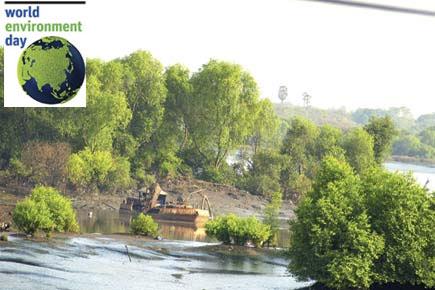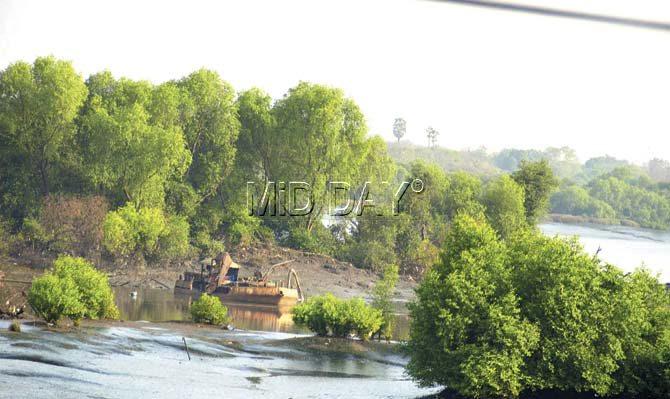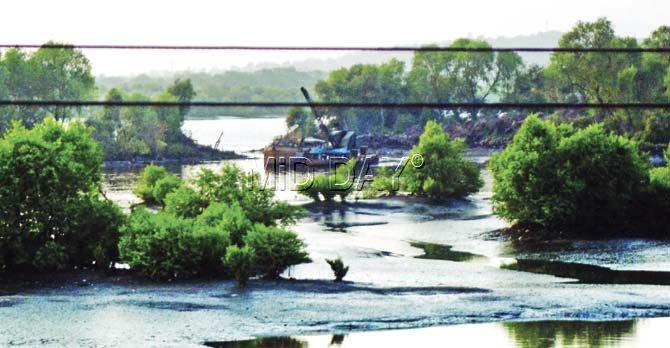On the occasion of World Environment Day, experts reveal how illegal sand dredging has not only robbed Ulhas Creek of 300 acres of precious mangroves, but is also slowly converting it into a flood risk

 Just a decade ago, Ulhas Creek was swathed in green with acres of mangroves spread across the water inlet, a sight for sore eyes for commuters on the Central Railway tracks that run alongside.
Just a decade ago, Ulhas Creek was swathed in green with acres of mangroves spread across the water inlet, a sight for sore eyes for commuters on the Central Railway tracks that run alongside.
ADVERTISEMENT
Also read: How 1 acre of mangroves vanished in nine years
The picture is very different today, however, with illegal sand mining slowly destroying the waterway, erasing its green cover and destroying 300 acres of mangroves between Diva and Dombivli.

When mid-day visited the creek on Wednesday and Thursday, we found sand dredging work going on in full swing, even though the Collector’s office had assured that action was being taken against the culprits. Pic/Shrikant Khuperkar
Quite apart from the loss of the precious mangroves and all the wildlife that called it home, this constant erosion of the creek has caused it to overrun its embankments, with the water nearly touching the railway tracks now. This is what makes it more than just an ecological concern, say experts, who warn that with the monsoon and continuing sand mining activity, the creek will keep widening and rising until it becomes a flood hazard.

According to experts, not only does the dredging have enormous ecological cost, but it also poses a threat to humans as the creek has now become a flood threat due to its destabilised basin and embankments. Pic/Bipin Kokate
Sand dredging
The changes in the creek are evident from pictures across the past decade (see pics), and experts point out that the mangroves are dying because of rampant sand dredging being carried out. Dozens of dredging boats, giant suction pumps, and cranes are at work in the water body every day, illegally sucking out sand from the basin to supply it to cement manufacturers.
According to Stalin Dayanand, director of the NGO Vanashakti, this has led to the disappearance of 300 acres of mangroves in the belt. The NGO has been fighting to protect the mangroves and has even approached the Bombay High Court on the matter.
“The officials always claim that this issue is not under their jurisdiction, and in spite of a clear court order restricting sand mining, the degradation of the basin of the creek is continuing even day and night,” said Dayanand. He pointed out that a few years ago, this stretch was a crucial bird habitat with species such as pond heron, white throated kingfisher, migratory birds like flamingos, for whom this was a nesting site.
However, with the destruction of the habitat, the birds have stopped visiting. Equally worrying is the threat this destruction poses to humans, however. “Earlier, the creek’s width was less and the water was at quite a distance from the railway lines. Over the years, the water has crept closer and now threatens to flood the tracks,” Dayanand explained.
Apathy?
Despite the obvious ecological cost and the flood risk involved, the authorities have had trouble putting an end to the sand mining menace so far. In fact, sand mining is banned in the seven districts of Maharashtra, especially on the coast, but the illegal activity is still rampant.
Also read: Mangroves along Thane creek under threat from SEZ project
The main reason for this is demand from the real estate sector, which needs the sand to produce cement. “All this is possible because of the involvement of local politicians, the sand mafia, and government authorities.
There is a need for an enforcement mechanism that can especially look into this issue, as visiting such deserted areas is not feasible and safe. We have travelled across and have faced death threats and were even attacked.
There is a need of continuous patrolling, and satellite images should be considered for a proper vigilance of the actual situation on ground,” said Sumaria Abdulali from the Awaaz Foundation, which is also fighting against the issue.
 Subscribe today by clicking the link and stay updated with the latest news!" Click here!
Subscribe today by clicking the link and stay updated with the latest news!" Click here!






